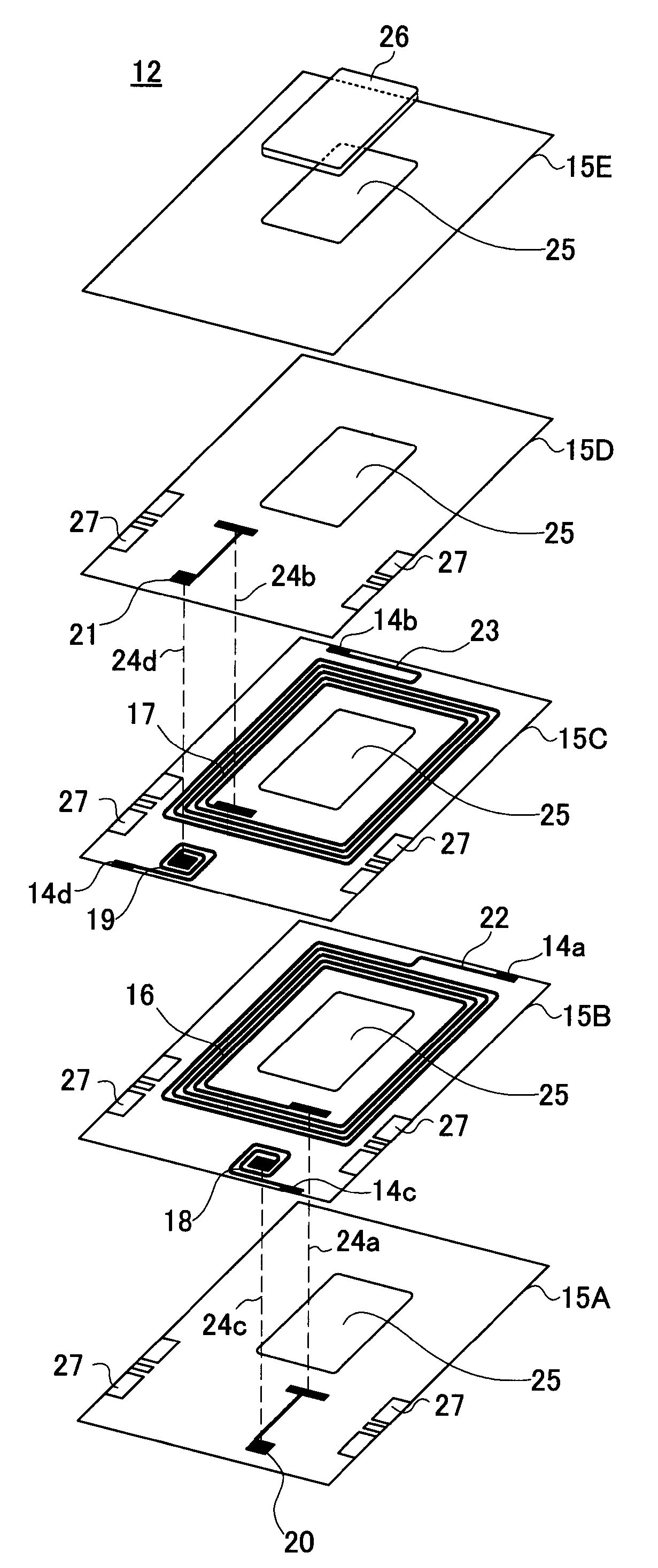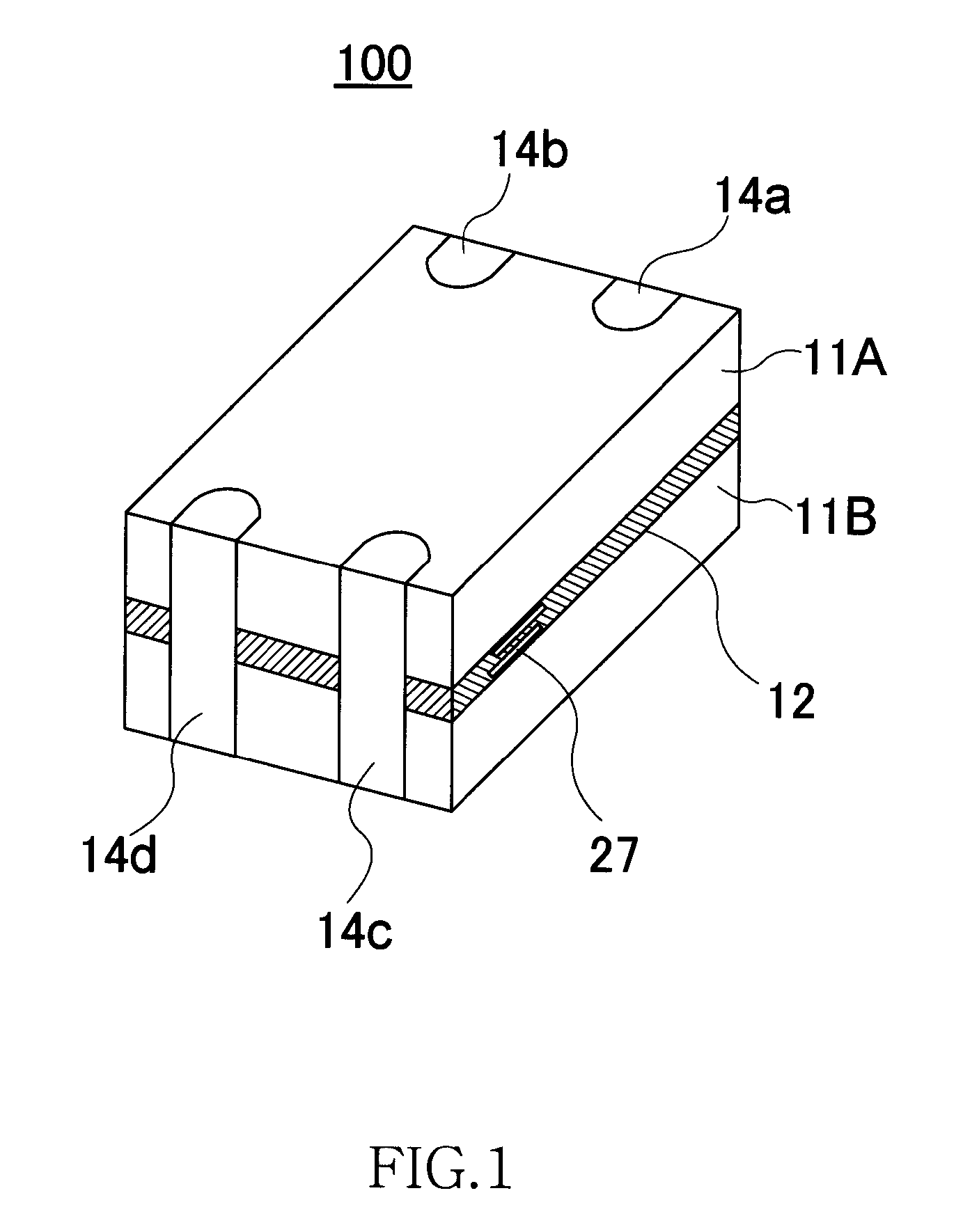Common mode choke coil
a choke coil and common-mode technology, applied in the direction of transformer/inductance details, basic electric elements, inductances, etc., can solve the problems of return loss, reflected and attenuated signals transmitted through the transmission channel, and high-frequency signals (200 mhz or higher) or high-speed pulse signals. , to achieve the effect of enhancing the insulation resistance of voltage and reducing the effect of the third and fourth coil conductors
- Summary
- Abstract
- Description
- Claims
- Application Information
AI Technical Summary
Benefits of technology
Problems solved by technology
Method used
Image
Examples
first embodiment
[0033]FIG. 1 is a schematic perspective view showing a structure of a common mode choke coil 100 according to the present invention.
[0034]As shown in FIG. 1, the common mode choke coil 100 is a thin-film type coil, and is provided with first and second magnetic substrates (magnet layers) 11A, 11B and a layer assembly 12 interposed between the first magnetic substrate 11A and the second magnetic substrate 11B. Terminal electrodes 14a through 14d are formed in the external peripheral surface of a layered body composed of the first magnetic substrate 11A, the layer assembly 12, and the second magnetic substrate 11B. A directional mark 27 described in detail hereinafter is also formed on the side surface of the common mode choke coil 100.
[0035]The first and second magnetic substrates 11A, 11B physically protect the layer assembly 12 and serves as a closed magnetic circuit of the common mode choke coil. Sintered ferrite, composite ferrite (a resin containing powdered ferrite), or the lik...
second embodiment
[0059]FIG. 4 is a schematic exploded perspective view showing the structure of the common mode choke coil 200 of the present invention, and shows the detailed structure of the layer assembly 12. Therefore, the magnetic substrates 11A, 11B and the magnetic body 26 in FIG. 4 are omitted.
[0060]As shown in FIG. 4, the characteristic features of the common mode choke coil 200 are that the common mode choke coil 200 has a three-layer layer assembly 12, and that the first contact conductor 20 and the second contact conductor 21 are both formed on the third insulation layer 150. The first coil conductor 16 and the third coil conductor 18 are formed on the first insulation layer 15A, and the second coil conductor 17 and the fourth coil conductor 19 are formed on the second insulation layer 15B. Since the other structural aspects are the same as in first embodiment, the same symbols are used to refer to the constituent elements that are the same in both embodiments, and no detailed descripti...
third embodiment
[0061]FIG. 5 is a schematic exploded perspective view showing the structure of the common mode choke coil 300 of the present invention, and shows the detailed structure of the layer assembly 12. Therefore, the magnetic substrates 11A, 11B and the magnetic body 26 in FIG. 5 are omitted.
[0062]As shown in FIG. 5, the characteristic features of the common mode choke coil 300 are that the common mode choke coil 300 has a three-layer layer assembly 12, and that the first contact conductor 20 and the second contact conductor 21 are both formed on the second insulation layer 15B. In other words, the first and second contact conductors 20, 21 are formed between the coil layers. Since the other structural aspects are the same as in first embodiment, the same symbols are used to refer to the constituent elements that are the same in both embodiments, and no detailed description thereof will be given. According to the present embodiment, one of the insulation layers can be omitted, and a commo...
PUM
| Property | Measurement | Unit |
|---|---|---|
| frequency | aaaaa | aaaaa |
| impedance | aaaaa | aaaaa |
| thickness | aaaaa | aaaaa |
Abstract
Description
Claims
Application Information
 Login to View More
Login to View More - R&D
- Intellectual Property
- Life Sciences
- Materials
- Tech Scout
- Unparalleled Data Quality
- Higher Quality Content
- 60% Fewer Hallucinations
Browse by: Latest US Patents, China's latest patents, Technical Efficacy Thesaurus, Application Domain, Technology Topic, Popular Technical Reports.
© 2025 PatSnap. All rights reserved.Legal|Privacy policy|Modern Slavery Act Transparency Statement|Sitemap|About US| Contact US: help@patsnap.com



